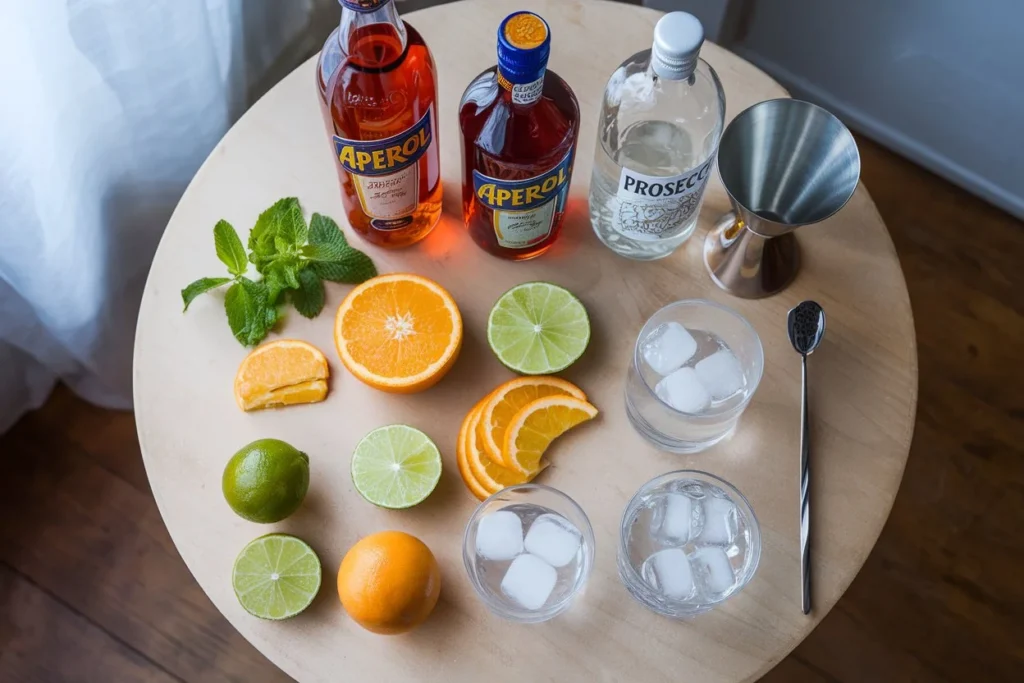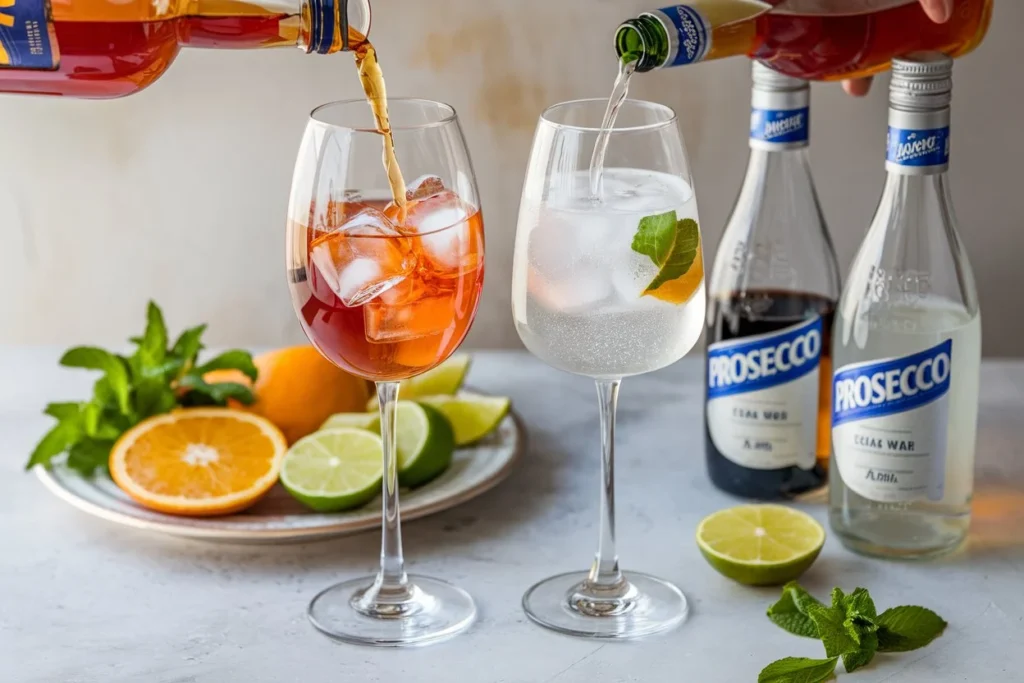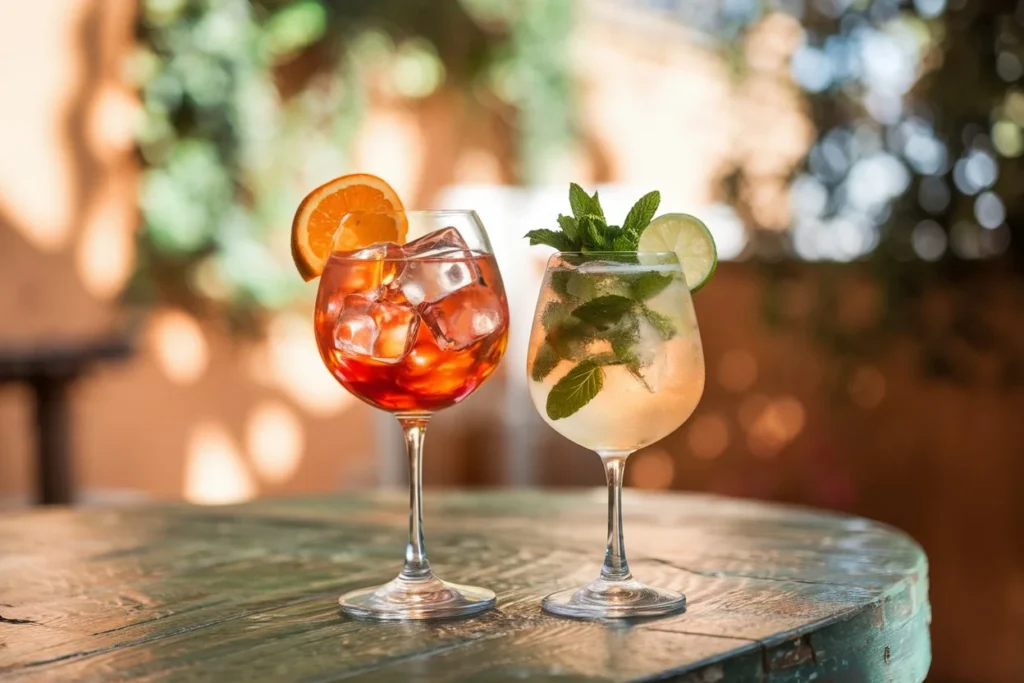In the world of refreshing Italian cocktails, the Aperol Spritz and Hugo Spritz stand out as irresistible options. But have you ever wondered what sets them apart? Each drink has a unique history, distinct flavors, and its own loyal following. From their ingredients and preparation methods to their cultural significance, every detail offers a story. This guide explores the differences between Aperol Spritz and Hugo Spritz, highlighting their origins, flavors, and global popularity.
Understanding Aperol and Hugo Spritz
Aperol Spritz: A Vibrant Classic
Aperol Spritz, with its iconic orange hue, is the epitome of a traditional Italian aperitif. It traces its origins back to Venice, Italy, where it became a popular pre-dinner drink. The cocktail starts with Aperol, a bittersweet liqueur featuring orange, rhubarb, and herbal notes. Mixed with prosecco, soda water, and an orange slice, it becomes a bubbly drink perfect for sunny afternoons with friends.
Its allure doesn’t just stop at flavor—Aperol Spritz symbolizes leisure and conviviality. No wonder it’s a go-to in Italy and beyond for those seeking a refreshing yet sophisticated beverage.
Hugo Spritz: A Floral Revelation
In contrast, Hugo Spritz is a newer addition to the cocktail world. Originating in South Tyrol, a region in Northern Italy, it exudes a floral elegance. Unlike Aperol, Hugo’s key ingredient is elderflower liqueur, offering a sweet and fragrant profile. It’s mixed with prosecco, soda water, and garnished with fresh mint leaves and lime for an invigorating finish.
This drink became popular for its versatility and lighter taste, perfect for those who enjoy a sweeter, less bitter alternative to the Aperol Spritz. Whether served before dinner or at a casual gathering, the Hugo Spritz offers a fresh, aromatic experience that’s irresistible.
The first step in distinguishing the difference between Aperol and Hugo Spritz lies in understanding their individual essence. From their bold beginnings to their subtle flavors, both beverages offer a delightful dive into Italy’s rich cocktail heritage.
Historical Background
Origins of Aperol Spritz
The story of the Aperol Spritz begins in the early 20th century, with its creation credited to the Barbieri brothers in 1919 in Padua, Italy. Aperol itself was marketed as a low-alcohol aperitif, designed to be light, refreshing, and perfect for social gatherings. The concept of the “spritz” dates back to the 1800s, during the Austrian Empire’s rule in Northern Italy. Austrian soldiers, finding Italian wines too strong, diluted them with sparkling water. This practice eventually evolved into the spritz culture we know today.
Aperol became the cornerstone of this cocktail, paired with prosecco and soda water to create the vibrant drink we know today. Its global fame rose in the 21st century through marketing campaigns highlighting its stylish and leisurely appeal.
Emergence of Hugo Spritz
While the Aperol Spritz has a century-old heritage, the Hugo Spritz is a more recent phenomenon. Created in 2005 by Roland Gruber, a bartender from South Tyrol, the Hugo was designed as a fresh alternative to the Aperol Spritz. The choice of elderflower syrup or liqueur gave it a floral twist, setting it apart from the bittersweet nature of its counterpart.
Named on a whim—Gruber reportedly chose “Hugo” because it sounded pleasant—the drink quickly gained popularity in Northern Italy and spread across Europe. Its easy-to-make recipe and fragrant, light taste made it a favorite, especially in summer months. Today, the Hugo Spritz is celebrated as a chic and refreshing cocktail for those seeking something elegant and unique.
Ingredients and Preparation
Aperol Spritz Components
The magic of an Aperol Spritz lies in its simplicity. Its ingredients are:
- Aperol: The star of the drink, offering a blend of orange zest, rhubarb, and herbal notes.
- Prosecco: A sparkling wine that adds effervescence and balances the bitter-sweetness of Aperol.
- Soda water: A splash of soda lightens the drink, ensuring a crisp finish.
- Orange slice: Typically used as a garnish, it reinforces the citrusy aroma and enhances visual appeal.
This classic combination creates a refreshing cocktail with a harmonious mix of bitter, sweet, and bubbly. Served over ice, the Aperol Spritz is more than a drink—it’s a sensory experience.
Hugo Spritz Ingredients

The Hugo Spritz is equally straightforward but features a unique set of elements:
- Elderflower liqueur or syrup: The heart of the Hugo, it provides a sweet, floral aroma that defines the drink.
- Prosecco: Just like in Aperol Spritz, prosecco serves as the bubbly base.
- Soda water: Adds a touch of fizz and lightness to the cocktail.
- Mint leaves: Infused for freshness, mint is both a garnish and a key flavor.
- Lime wedge: Offers a hint of citrusy tang to balance the sweetness.
This blend results in a bright, fragrant cocktail that’s refreshingly sweet and perfectly suited for warm days.
Preparation Methods Compared

Both Aperol and Hugo Spritzes share a similar preparation method but with subtle differences:
- Aperol Spritz: Fill a large wine glass with ice, pour three parts prosecco, two parts Aperol, and one part soda water. Stir gently to combine, then garnish with an orange slice. The emphasis here is on creating a perfect balance between the bittersweet Aperol and the light, fizzy base.
- Hugo Spritz: Start by filling a glass with ice. Add a generous splash of elderflower liqueur or syrup, followed by prosecco and soda water in equal parts. Stir gently, then add fresh mint leaves and a lime wedge. The lime’s acidity and mint’s refreshing burst enhance the cocktail’s aromatic charm.
While both drinks are equally photogenic and delicious, the Hugo Spritz leans towards sweet and floral, whereas the Aperol Spritz is all about bittersweet sophistication.
Flavor Profiles
Tasting Notes of Aperol Spritz
The Aperol Spritz is a tantalizing blend of bold flavors and gentle effervescence. Its most distinctive quality is its bittersweet character, which comes from the Aperol liqueur. On the first sip, you’ll notice a zesty orange kick, quickly followed by herbal and slightly earthy undertones from rhubarb and a mix of aromatic herbs.
The prosecco base lends a dry, sparkling quality, cutting through the sweetness and bitterness to create balance. Soda water lightens the body, making the drink feel crisp and refreshing, while the orange garnish enhances the citrusy aroma. Together, these elements create a drink that feels both bold and refreshing—a true homage to Italian aperitivo culture.
Tasting Notes of Hugo Spritz
In contrast, the Hugo Spritz offers a floral and slightly sweet profile that’s less intense than its Aperol counterpart. The key player here is elderflower liqueur or syrup, which imparts a delicate, nectar-like sweetness. It’s this floral element that makes the drink stand out.
Prosecco adds a touch of effervescence, keeping the drink light and bubbly. Mint leaves lend an invigorating burst of freshness, while lime provides a subtle tanginess that balances the sweetness. Every sip is a harmonious interplay of sweet, citrus, and herbaceous flavors—a refreshing, aromatic treat for your palate.
Comparative Analysis
When comparing the Aperol Spritz and Hugo Spritz, their distinct characteristics become clear. The Aperol Spritz is more robust, with its bittersweet flavors appealing to those who enjoy a bold aperitif. The bright orange zest and herbal complexity make it ideal for pairing with salty snacks like olives or chips.
The Hugo Spritz offers lightness and sweetness, making it ideal for those who enjoy a milder flavor. Its floral, minty, and citrusy notes evoke springtime with every sip, making it perfect for casual outdoor gatherings.
While the Aperol Spritz is a symbol of classic Italian sophistication, the Hugo Spritz feels like a modern, refreshing twist—ideal for those who crave something different yet equally delightful.
Alcohol Content and Strength
Alcohol by Volume in Aperol Spritz
The Aperol Spritz is known for being a low-alcohol cocktail, making it a suitable choice for leisurely sipping. Aperol itself has an alcohol by volume (ABV) of 11%, which is relatively mild compared to spirits like vodka or gin. When mixed with prosecco (11-12% ABV) and soda water, the overall ABV of the Aperol Spritz usually falls between 8% and 10%.
This makes it ideal as an aperitif, designed to stimulate the appetite without being overly intoxicating. Its balance of alcohol content and flavor ensures you can enjoy it during social occasions without feeling overwhelmed.
Alcohol by Volume in Hugo Spritz
Similarly, the Hugo Spritz is also a low-alcohol cocktail, but its exact ABV can vary depending on the choice of elderflower liqueur or syrup. Elderflower liqueur typically has an ABV of around 20%, but when mixed with prosecco and soda water, the cocktail’s ABV is diluted to approximately 6% to 8%.
This makes the Hugo Spritz slightly lighter than the Aperol Spritz, further enhancing its reputation as a refreshing and easy-to-drink option. Its lower alcohol content makes it a favorite for daytime events and brunches.
Implications for Consumption
The low alcohol content of both the Aperol Spritz and Hugo Spritz makes them versatile choices for a variety of occasions. Whether you’re enjoying an outdoor aperitivo or mingling at a social event, these cocktails allow for extended sipping without the risk of quick inebriation.
However, the Aperol Spritz’s slightly higher alcohol level might give it a more pronounced warming sensation, while the Hugo Spritz’s lighter profile encourages a breezier drinking experience. Ultimately, the choice depends on personal preference—whether you lean towards bittersweet complexity or light floral sweetness.
Popularity and Cultural Significance
Aperol Spritz in Italian Culture
The Aperol Spritz has become synonymous with Italian aperitivo culture—a cherished tradition that involves light, pre-dinner drinks paired with snacks to encourage conversation and relaxation. Originating in Northern Italy, particularly in Venice, this vibrant cocktail quickly became a staple at bars and cafés, where patrons gather to unwind after a long day.
Aperol’s marketing campaigns further cemented its place in Italian life, portraying the drink as a symbol of elegance and leisure. Its bright orange hue and refreshing taste evoke the sunny Italian Riviera, creating an irresistible allure for locals and tourists alike. From bustling piazzas to picturesque seaside towns, the Aperol Spritz is a quintessential element of Italian social rituals, celebrated for its ability to bring people together.
Hugo Spritz’s Regional Popularity
While the Aperol Spritz enjoys nationwide acclaim, the Hugo Spritz has its roots firmly planted in South Tyrol, a region nestled in the Italian Alps. This drink reflects the region’s love for fresh, aromatic flavors and its appreciation for nature’s bounty. Hugo’s unique combination of elderflower, mint, and prosecco feels deeply tied to the lush landscapes of Northern Italy, where alpine herbs and floral ingredients are abundant.
Although initially regional, the Hugo Spritz’s appeal quickly spread throughout Italy and neighboring European countries. Its refreshing taste and floral notes captured the hearts of those looking for a modern alternative to traditional aperitifs. Today, Hugo Spritz remains a beloved drink, especially during the warmer months, offering a taste of Northern Italian charm.
Global Trends and Preferences
The popularity of the Aperol Spritz and Hugo Spritz has transcended borders, with both cocktails gaining international recognition in recent years. Aperol Spritz, bolstered by global advertising campaigns, became a fixture on cocktail menus worldwide, particularly in trendy urban hotspots. Its association with chic summer gatherings and its Instagram-worthy appearance helped it gain a devoted following.
Meanwhile, the Hugo Spritz carved its niche among those seeking a lighter, more aromatic alternative. In regions where floral and herbal flavors are appreciated, the Hugo Spritz became a refreshing choice for outdoor dining and casual get-togethers. Together, these cocktails showcase the global fascination with Italian culture and its emphasis on enjoying life’s simple pleasures.
Nutritional Information
Caloric Content of Aperol Spritz
An Aperol Spritz is not only refreshing but also relatively moderate in calories, making it a popular choice for those mindful of their intake. A standard serving contains approximately 125-150 calories, depending on the proportions used and the type of prosecco. Most of these calories come from Aperol, which includes added sugars that contribute to its bittersweet flavor.
The addition of soda water helps dilute the drink, keeping its caloric impact lower than other cocktails. For those looking to reduce calories further, opting for less Aperol or a lighter prosecco can make a difference.
Caloric Content of Hugo Spritz
The Hugo Spritz is slightly sweeter than the Aperol Spritz, which translates to a marginally higher calorie count. A typical serving has around 140-160 calories. The elderflower liqueur or syrup used in Hugo Spritz is the main contributor, as it contains natural sugars that enhance its floral sweetness.
Like the Aperol Spritz, soda water plays a role in keeping the drink light. To reduce calories, using elderflower syrup instead of liqueur can make a noticeable difference.
Health Considerations
Both cocktails are relatively low in calories compared to heavier alcoholic beverages, making them popular for those who want to enjoy a drink without overindulging. However, the sugar content in both Aperol and elderflower liqueur warrants moderation, especially for those watching their sugar intake.
The low alcohol content also means these drinks are less taxing on the body, making them a suitable option for extended social occasions. As always, consuming in moderation and pairing the cocktails with healthy snacks can ensure a balanced, enjoyable experience.
Variations and Alternatives
Aperol Spritz Variations
The Aperol Spritz may be a classic, but creative twists on the original recipe have given rise to numerous variations. One popular option is the Cynar Spritz, where Aperol is swapped for Cynar, an artichoke-based liqueur that adds earthy, herbal notes. This variation appeals to those who prefer a more bitter profile.
For a fruitier take, some bartenders incorporate seasonal fruits such as strawberries, blood oranges, or pomegranate seeds to enhance the cocktail’s flavor and presentation. Another trendy variation is the Frozen Aperol Spritz, a slushy version of the drink, perfect for hot summer days.
Prosecco can also be substituted with other sparkling wines, like cava or champagne, to create subtle differences in taste. Ultimately, the Aperol Spritz serves as a versatile base that encourages experimentation while maintaining its iconic bittersweet character.
Hugo Spritz Variations
The Hugo Spritz is equally adaptable, with bartenders finding new ways to highlight its floral and herbal notes. One variation involves swapping elderflower liqueur with St-Germain, a premium elderflower spirit that offers a more robust and refined flavor.
For a less sweet version, bartenders may use elderflower cordial instead of syrup or liqueur, reducing the drink’s sugar content while preserving its floral essence. Adding fruits like fresh berries or thin cucumber slices can lend additional layers of freshness.
Some prefer to infuse their Hugo Spritz with flavored sparkling waters or even use rosé prosecco to add a hint of pink and a slightly different taste. These customizations demonstrate the versatility of the Hugo Spritz and its ability to cater to various preferences.
Other Similar Cocktails
Both Aperol and Hugo Spritz have inspired a growing interest in spritz cocktails, leading to the popularity of similar drinks. The Campari Spritz is a notable alternative for those who enjoy a more intense bitter flavor, as it replaces Aperol with the stronger, bolder Campari.
For a completely different take, the Limoncello Spritz combines the sweetness of limoncello with prosecco and soda water, creating a bright and citrusy cocktail ideal for summer. Another favorite is the Negroni Sbagliato, which replaces gin with sparkling wine, offering a bubbly twist on the classic Negroni.
These variations highlight the enduring appeal of spritz cocktails, showcasing their adaptability and universal charm.
Frequently Asked Questions
What is a Hugo Spritz made of?
A Hugo Spritz is a refreshing cocktail with a floral and minty profile, making it a perfect choice for warm weather. Its main ingredients include elderflower liqueur or syrup, prosecco, and soda water. These components are mixed in a wine glass filled with ice, creating a bubbly and aromatic drink.
To enhance its flavor and appearance, fresh mint leaves and a wedge of lime are added as garnishes. The elderflower provides a sweet, fragrant base, while the mint and lime introduce a burst of freshness and a touch of citrusy tang. This simple yet elegant combination makes the Hugo Spritz a crowd-pleaser at gatherings and a staple of modern cocktail culture.
What is the Aperol Spritz controversy?
The Aperol Spritz sparked controversy in 2019 when a prominent food critic labeled it as “not a good drink.” The critique centered on its perceived lack of complexity, citing low-quality prosecco and the overly sweet taste of Aperol as detractors. This critique ignited a debate within the cocktail community, polarizing opinions about the drink’s quality and its massive commercial appeal.
Despite the criticism, fans of the Aperol Spritz defended its cultural significance, highlighting its role as a light, refreshing aperitif. The debate underscored the subjective nature of taste and reinforced the cocktail’s popularity as a symbol of Italian leisure and conviviality.
What is the most popular spritz in Italy?
The Aperol Spritz holds the title of the most popular spritz in Italy, a distinction it has earned through its long-standing history and vibrant flavor. Its bittersweet, effervescent character makes it a favorite during aperitivo hour, and its iconic orange hue is instantly recognizable in bars and cafés across the country.
While regional favorites like the Hugo Spritz enjoy localized popularity, the Aperol Spritz remains the nationwide classic. Its global marketing campaigns and Instagram-worthy appearance have further cemented its status as the quintessential Italian spritz.
What liquor is comparable to Aperol?
Campari is often considered the most comparable liquor to Aperol, as both are Italian aperitifs with a bittersweet flavor profile. However, Campari has a bolder and more bitter taste compared to Aperol’s lighter, sweeter notes.
Other alternatives include Select Aperitivo, which is less sweet but has a similar herbal complexity, and Cappelletti Aperitivo, known for its rich, wine-based flavor. These substitutes can be used in cocktails to replicate or reinterpret the Aperol Spritz with unique variations.
Can I substitute Aperol in a Hugo Spritz?
Technically, Aperol can be substituted in a Hugo Spritz, but doing so changes the drink’s flavor significantly. The Hugo Spritz is defined by its elderflower liqueur, which gives it its signature floral and sweet character. Replacing it with Aperol results in a more bittersweet cocktail, leaning closer to the profile of an Aperol Spritz.
For those who prefer a slightly bitter twist on the Hugo, adding a splash of Aperol alongside the elderflower liqueur can create a delightful fusion of flavors. However, the original Hugo Spritz’s charm lies in its floral elegance, which might be lost with this substitution.
Which drink has more alcohol content?
Between the Aperol Spritz and Hugo Spritz, the Aperol Spritz typically has a slightly higher alcohol content. Aperol has an alcohol by volume (ABV) of 11%, and when mixed with prosecco (11-12% ABV) and soda water, the overall cocktail ranges from 8% to 10% ABV.
The Hugo Spritz, on the other hand, often contains elderflower liqueur, which has a higher ABV (around 20%). However, since it is used in smaller quantities and diluted with prosecco and soda water, the final drink usually has an ABV of 6% to 8%. This makes the Hugo Spritz lighter in terms of alcohol, catering to those who prefer a more subdued option.
Conclusion
Summarizing the Differences
The Aperol Spritz and Hugo Spritz stand as two distinct icons in the world of Italian cocktails, each catering to different tastes and occasions. The Aperol Spritz, with its bittersweet and citrusy profile, appeals to those who enjoy bold flavors with a hint of herbal complexity. Its vibrant orange hue and association with aperitivo culture have made it a symbol of Italian leisure.
The Hugo Spritz, in contrast, offers a lighter, sweeter experience, thanks to its elderflower base, minty freshness, and citrusy accents. Rooted in Northern Italy, it embodies a modern twist on traditional cocktails, delivering floral and refreshing notes perfect for spring and summer gatherings.
While both share the spritz structure of prosecco and soda water, their ingredients and flavor profiles set them apart, allowing drinkers to choose based on mood, preference, and occasion.
Final Thoughts and Recommendations
Ultimately, the choice between the Aperol Spritz and Hugo Spritz depends on personal taste. If you prefer a bold, bittersweet aperitif, the Aperol Spritz is your go-to drink. For those leaning toward something lighter, aromatic, and slightly sweet, the Hugo Spritz is an ideal alternative.
Both drinks are incredibly versatile and lend themselves to endless variations, making them staples in any cocktail enthusiast’s repertoire. Whether you’re basking in the sun with a Hugo or enjoying a sunset aperitivo with an Aperol Spritz, these beverages celebrate the Italian art of enjoying life one sip at a time. So why not try both and discover your favorite? Cheers!

